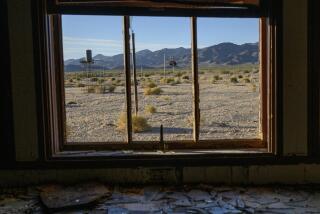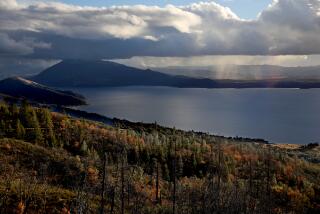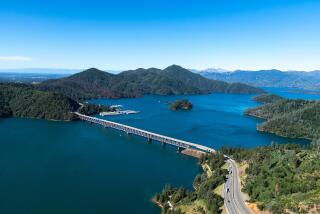Is warming a clear danger for Tahoe?
- Share via
SACRAMENTO -- — Global climate change may be causing a pivotal shift in the depths of Lake Tahoe that could fundamentally alter its ecology by the end of the next decade and turn its famed jewel-blue waters a murky hue, according to a recent study.
The research and computer modeling by scientists at UC Davis predict that warming could limit the lake’s natural mixing cycle, disrupting the food web and potentially robbing it of the clarity that has helped make Tahoe a world-class tourist destination.
Experts from the university’s Tahoe Environmental Research Center suspect the changes could occur within a decade and prove irreversible. Among the likely results are fewer native fish and larger populations of invasive species, such as large-mouth bass, bluegill and carp.
But the most visible shift could be to its waters, which have inspired awe since the Gold Rush days, earning Tahoe the nickname “Jewel of the Sierra.”
Those waters have been losing clarity as urban development carpeted the basin, prompting a crash government effort to stem the effect of runoff. The Tahoe region now has some of the toughest development and environmental rules in the world.
The latest threat to the lake, however, stems from the far more intractable problem of worldwide greenhouse gas emissions and a warming globe.
“Tahoe is another victim,” said John Reuter, the center’s associate director and one of the report’s authors. “The world views the lake as a pristine place, a refuge. When you hear global warming is affecting Tahoe, is anywhere safe? The answer is no.”
Tahoe residents working for years to save the lake said the study underscored the broad urgency of their fight.
“We’re not ready to decide that the solutions are out of our hands,” said Rochelle Nason, Keep Tahoe Blue executive director. “We remain optimistic we can protect the lake. But ultimately, the climate change issue will have to be addressed if we’re going to succeed in the long term.”
Reuter and the study’s other authors, the center’s director Geoffrey Schladow and postdoctoral researcher Goloka Sahoo, presented their findings last week at a Tahoe scientific conference.
A warming trend has been underway at the lake for at least 40 years. Although the surface water temperature has risen a single degree, Reuter said that was as significant as a one-digit change in the human body.
In the case of the lake, that means oxygen-rich surface water that was reliably churned into Tahoe’s 1,644-foot depths every four years is now less apt to circulate. Nutrients carted upward and oxygen cycled downward would ebb.
In the worst-case scenario, the study found, the mixing could halt entirely by as early as 2019, a time frame that Schladow said “was very surprising.”
If it happens, ecological fallout could come quickly.
“Then it’s not a matter of if, it’s a matter of when,” Reuter said.
Lake trout and other native fish would be forced to huddle in areas that still prove habitable. Phosphorous locked in the lake’s bottom sediments would be released, fueling algae blooms on the surface.
That could combine with other factors, such as particles in shoreline runoff, to rob the lake of clarity, turn the air foul and produce bad-tasting drinking water, the scientists said.
Many lakes in California and around the world suffer oxygen depletion, known as anoxia. Lake Tahoe, however, has historically been “above and beyond such things,” Schladow said. But without the natural mixing cycle, it becomes “just like any other lake or pond.”
The scientists are part of a half-century effort to study the lake, focusing on the causes of Tahoe’s declining clarity. UC Davis researchers reported the lake’s warming trend in 2004, and Schladow’s team built on those findings using a computer model that combined air temperatures, cloudiness and wind speed to determine scenarios for the traditional mixing cycle.
Reuter said the scientists felt most certain about the potential effects on fish and other aquatic life. Less clear is how warming-induced changes will influence Tahoe’s cobalt-blue color, he said. If the bottom phosphorous is released, the lake could quickly turn from blue to green.
Lake Tahoe is one of many in the world seeing warming waters, among them Lake Zurich and Lake Biwa in Japan. Researchers from Japan, New Zealand, Chile and the U.S. are attending the conference.
--






